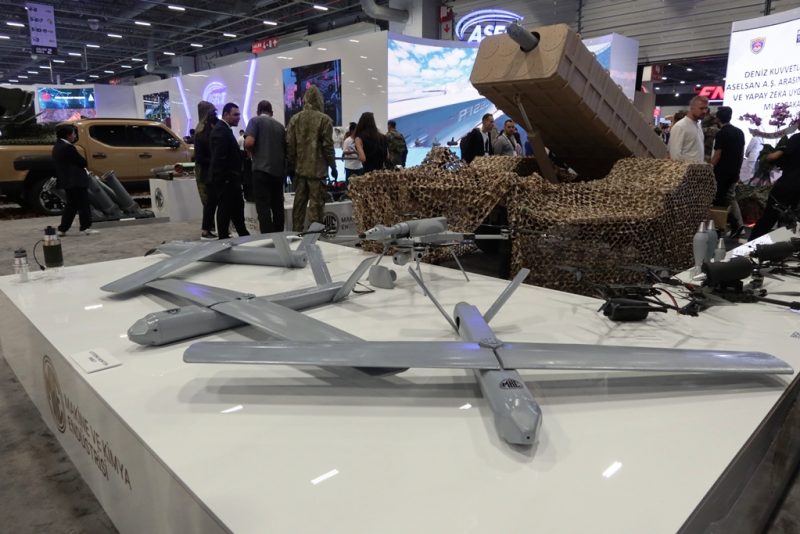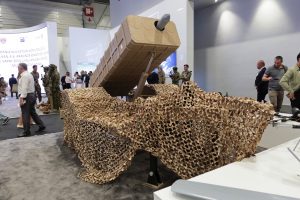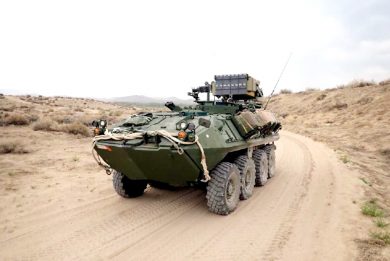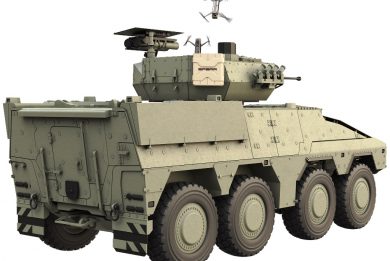IDEF 2025 – MKE unveils a new family of loitering munitions
Increasingly dominating the battlefield in recent conflicts, loitering munitions are being developed in numbers, new systems appearing at every exhibition. It was the case of IDEF 2025, where MKE, the Turkish National Defence Ministry subsidiary active in the ammunition and weapon systems field, unveiled a still unnamed new family of canister-launched loitering munitions
In the wide area dedicated to products under development by its R&D division, MKE unveiled a new family of loitering munitions, which can all be operated from a common launcher, which at the exhibition was shown in a eight-cell version mounted on a trailer, but which can certainly be declined in other configurations. EDR On-Line understood that the initial impulse is provided by a pneumatic system that ejects the munition, which then activates its propulsion system to reach maximum operational speed.
Scale models of three different munitions were exhibited, two of them powered by an electric motor while the third was featuring a turbine motor. EDR On-Line spoke to company representatives involved in the project to gather first-hand information on those new systems.
The airframe is very similar for all three and is mostly produced using carbon fibre to reduce mass; the fuselage has a near square section, and features two rear vertical empennage which fold forward, and two straight semi-wings that fold backward, in order to be able to fit within the form factor of the launch canister. At launch the empennages are the first to deploy to allow the semi-wings to rotate forward. No indications on wingspan and length were provided. The guidance system is based on GNSS and jamming resistance is provided thanks to the use of four CRPA (Controlled Reception Pattern Antenna) antennas. The munitions are designed to fly at low altitude to avoid radar detection, accuracy being 10 meters within target. The launcher can be integrated either on land or sea platforms.
The first version of the electric-powered munitions is fitted with the engine at the rear, activating a two-blade folding propeller, and has a launch mass of 20 kg, 5 kg being the mass of the warhead. It can reach a 140 km/h speed and has a range of 40 km. According to the brochure a high explosive-fragmentation warhead with steel balls should also be available. However at the exhibition EDR On-Line was told that a shaped charge warhead, ensuring high penetration against heavily armoured targets, was fitted, which explained the increased circular section of the front part of the fuselage. How this copes with the 10 metres CEP remains to be seen, a different seeker being possibly used when the antitank warhead is installed.
The second version is a jamming-resistant munition, which features fibre-optic guidance. As the fibre-optic reel is obviously located at the rear, the electric motor is here moved at the front and drives a two-blade folding propeller which opens after launch. To cope with the fibre unreeling the speed is reduced to 125 km/h, while the weight of the fibre also reduced the lethality payload, the 2 kg warhead being of the high explosive/fragmentation type with steel balls added to the explosive charge. The link provided by the fibre optic cable allows to maintain full control until the very last moment, therefore the munition can be used in an FPV (First Person View) mode.
EDR On-Line understood that the warhead has already be subjected to static tests, the airframe has flown, and complete flight tests should start soon, MKE engineers considering the product at TRL 6/7.
Last but not least comes the turbine powered version. According to information the small turbine engine, which runs on diesel, kerosene or JET A1 fuel, comes from Thailand and allows the airframe, which very remains similar to the others with the engine at the back, to reach a speed of over 300 km/h. Mass at take-off is 60 kg, of which 20 kg are represented by the high explosive fragmentation warhead, which has a lethal range of 25 metres. This version has an operational range of 65 km. Flight tests without the warhead have already been done, the next step being full system tests, the jet-powered munition being considered at TRL 6.
Phtos by P. Valpolini








